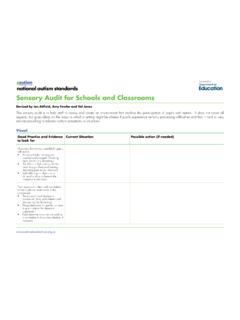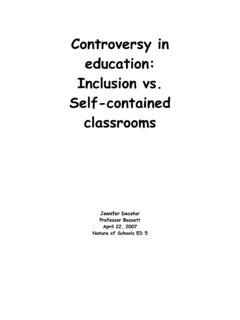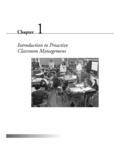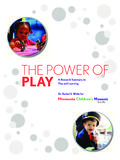Transcription of Windows and Classrooms: A Study of Student Performance …
1 CALIFORNIA ENERGY COMMISSION Windows and Classrooms: A Study of Student Performance and the indoor environment TECHNICAL REPORT October 2003 P500-03-082-A-7 Gray Davis, Governor CALIFORNIA ENERGY COMMISSION Prepared By: Heschong Mahone Group, Inc. Lisa Heschong, Project Director Fair Oaks, California Managed By: New Buildings Institute Cathy Higgins, Program Director White Salmon, Washington CEC Contract No.
2 400-99-013 Prepared For: Donald Aumann, Contract Manager Nancy Jenkins, PIER Buildings Program Manager Terry Surles, PIER Program Director Robert L.
3 Therkelsen Executive Director DISCLAIMER This report was prepared as the result of work sponsored by the California Energy Commission. It does not necessarily represent the views of the Energy Commission, its employees or the State of California. The Energy Commission, the State of California, its employees, contractors and subcontractors make no warrant, express or implied, and assume no legal liability for the information in this report; nor does any party represent that the uses of this information will not infringe upon privately owned rights. This report has not been approved or disapproved by the California Energy Commission nor has the California Energy Commission passed upon the accuracy or adequacy of the information in this report.
4 ACKNOWLEDGEMENTS This report is a part of the Integrated Energy Systems - Productivity and Buildings Science program, a Public Interest Energy Research (PIER) program. It is funded by California ratepayers through California's System Benefit Charges administered by the California Energy Commission (CEC) under (PIER) contract No. 400-99-013, and managed by the New Buildings Institute. Heschong Mahone Group would like to acknowledge the support and contributions of the individuals below: Heschong Mahone Group, Inc.: Principal in Charge: Lisa Heschong. Project Director: Lisa Heschong. Project staff: Puja Manglani tracked the statistical analysis of the data, collected data and contributed the report. Abhijeet Pande directed physical on-site data collection and contributed to the analysis and report.
5 Mudit Saxena performed the acoustic and radiant comfort analysis. Carey Knecht participated in data collection and edited the reports. Sean Denniston participated in data collection, processing and reporting. Cynthia Austin assisted with data processing. Jon McHugh and Douglas Mahone provided technical oversight. Lynn Benningfield provided project management support. Subcontractors: RLW Analytics, Inc: Dr. Roger Wright, directed statistical analysis and Ramona Peet, performed the analysis and contributed to the report. Cascadia Conservation: Barbara Erwine contributed to data collection, the Daylight Code classification, and review of the work. Review and Advisory Committee: Dr. Jed Waldman, California Department of Public Health; Dr. Gage Kingsbury, Northwest Evaluation Association; Dr.
6 Judith Heerwagen, private consultant; Abby Vogen, Energy Center of Wisconsin; Dr. Cliff Federspiel, Center for the Built environment , UC Berkeley; Danny S. Parker, Florida Solar Energy Center, Dr. Robert Wirtshafter, Wirtshafter Associates. Fresno Unified School District: FUSD Research and Evaluation Department: Dr Larry Zander the provided primary continuity and oversight of the project. Dr. Malati Gopal approved the project and Ed Dewitt helped evaluate and process data. Facilities Department: Mike Berg and Chuck McAlexander of the provided access to facilities data; Dwayne Allen assisted with provision of plans and photos; Lynn Peters Lynn Freeman and Boyd Cline facilitated access to facilities and provided useful historical background. Numerous other FUSD employees, including school principals, secretaries and janitors were most generous with their time and resources, providing information and support that was essential to the completion of this project.
7 PREFACE The Public Interest Energy Research (PIER) Program supports public interest energy research and development that will help improve the quality of life in California by bringing environmentally safe, affordable, and reliable energy services and products to the marketplace. This document is one of 33 technical attachments to the final report of a larger research effort called Integrated Energy Systems: Productivity and Building Science Program (Program) as part of the PIER Program funded by the California Energy Commission (Commission) and managed by the New Buildings Institute. As the name suggests, it is not individual building components, equipment, or materials that optimize energy efficiency. Instead, energy efficiency is improved through the integrated design, construction, and operation of building systems.
8 The Integrated Energy Systems: Productivity and Building Science Program research addressed six areas: Productivity and Interior Environments Integrated Design of Large Commercial HVAC Systems Integrated Design of Small Commercial HVAC Systems Integrated Design of Commercial Building Ceiling Systems Integrated Design of Residential Ducting & Air Flow Systems Outdoor Lighting Baseline Assessment The Program s final report (Commission publication #P500-03-082) and its attachments are intended to provide a complete record of the objectives, methods, findings and accomplishments of the Integrated Energy Systems: Productivity and Building Science Program. The final report and attachments are highly applicable to architects, designers, contractors, building owners and operators, manufacturers, researchers, and the energy efficiency community.
9 This Windows and Classrooms (Product # ) is a part of the final report within the Productivity and Interior Environments research area and presents the results of a Study into relationships between the indoor classroom environment and Student Performance . The Buildings Program Area within the Public Interest Energy Research (PIER) Program produced these documents as part of a multi-project programmatic contract (#400-99-413). The Buildings Program includes new and existing buildings in both the residential and the non-residential sectors. The program seeks to decrease building energy use through research that will develop or improve energy efficient technologies, strategies, tools, and building Performance evaluation methods. For other reports produced within this contract or to obtain more information on the PIER Program, please visit or contact the Commission s Publications Unit at 916-654-5200.
10 All reports, guidelines and attachments are also publicly available at ABSTRACT This Study investigates whether daylight and other aspects of the indoor environment in elementary school Student classrooms have an effect on Student learning, as measured by their improvement on standardized math and reading tests over an academic year. The Study uses regression analysis to compare the Performance of over 8000 3rd through 6th grade students in 450 classrooms in the Fresno Unified School District, located in California s Central Valley. Statistical models were used to examine the relationship between elementary students test improvement and the presence of daylight in their classrooms, while controlling for traditional education explanatory variables, such as Student and teacher demographic characteristics.








